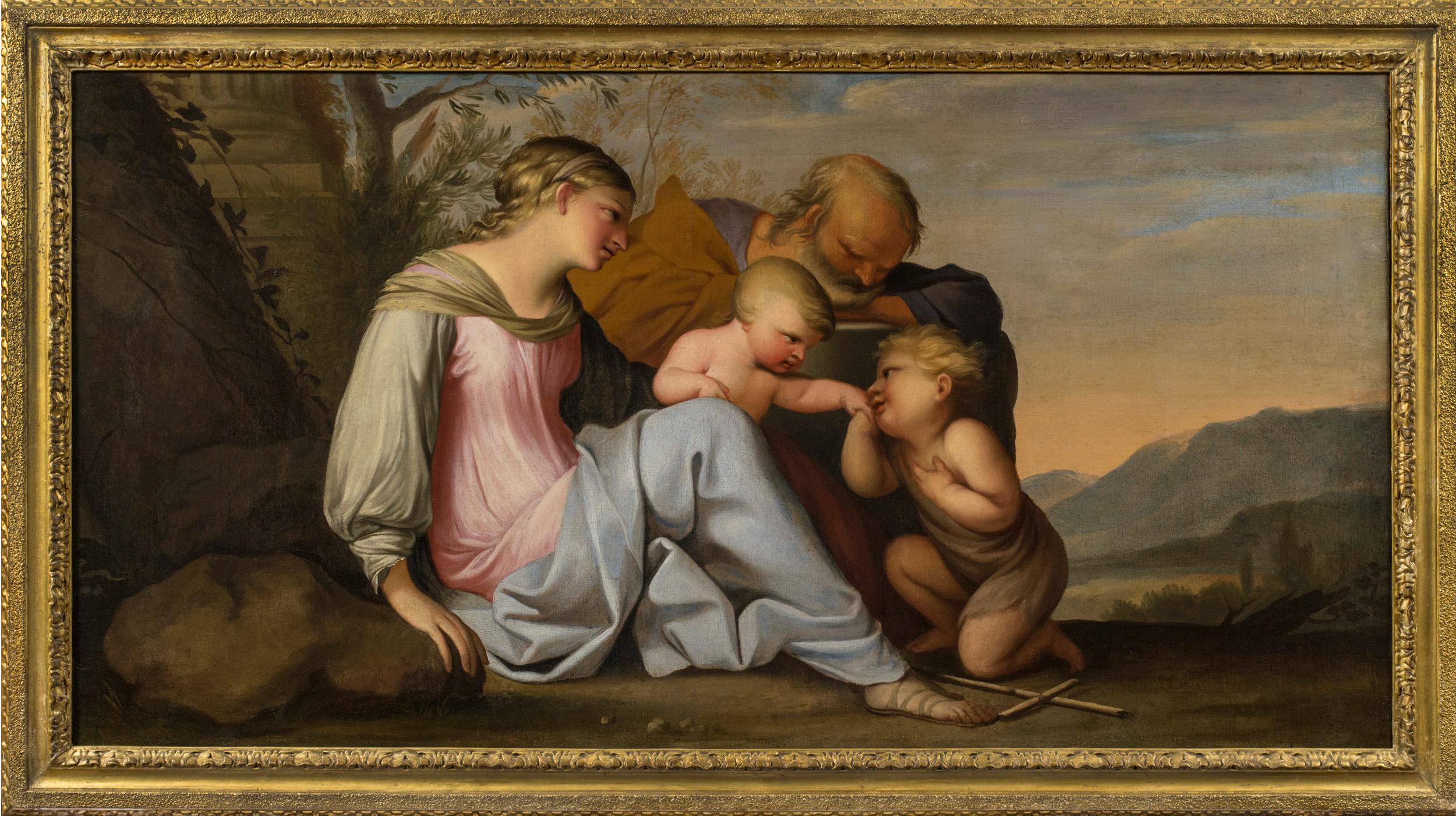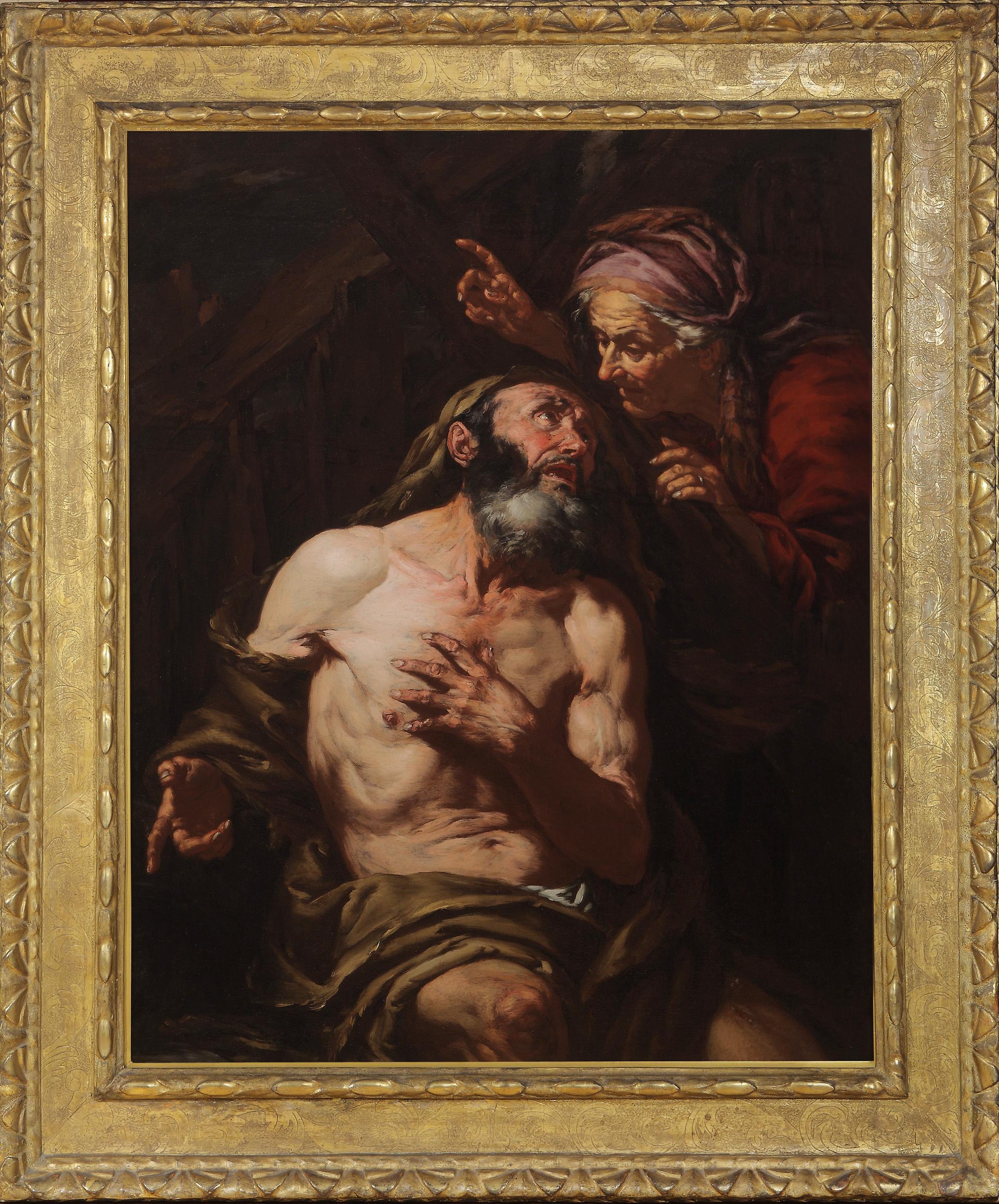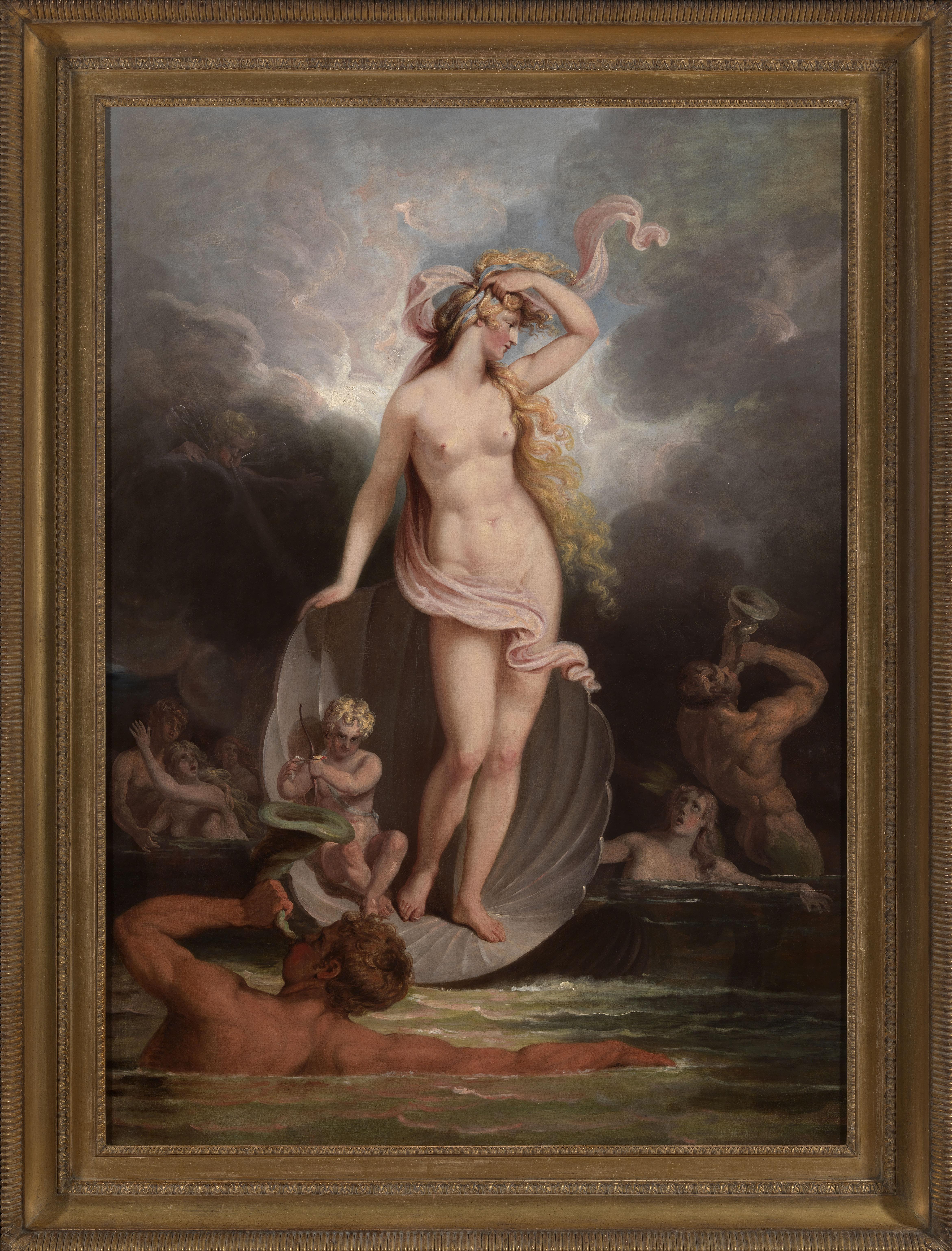Items Similar to Testa di Santo Martire
Want more images or videos?
Request additional images or videos from the seller
1 of 7
Sebastiàn de Llanos ValdèsTesta di Santo Martire1650
1650
About the Item
Sebastàn de Llanos Valdès (circa 1605-1677) testa di santo martire
Olio su tela, cm 50,5x72,5
Non vi sono dubbi in merito all’autografia del dipinto che spetta a Sebastian de Llanos y Valdes (1616-1677), come testimonia l’ iscrizione frammentaria posta nel margine inferiore destro della composizione. Il pittore spagnolo fu allievo di Herrera il Vecchio (1576-1656), poliedrico artista suo conterraneo, abile oltre che nel dipingere anche nella lavorazione del bronzo e nel campo della medaglistica. Nella famosa bottega dell’ Herrera, cui viene attribuito il ruolo di fondatore della famosa Scuola di Siviglia, gravitarono anche il tredicenne Velasquez, che vi rimase per un intero ano, e Ignacio de Riarte. Nel nostro dipinto raffigurante la testa mozzata di un santo martire posta su un’erta rocciosa si può cogliere l’ aderenza al dato reale nei dettagli del volto corrugato e sofferente e nella realizzazione dello spasimo della bocca aperta, incorniciata da una lunga e folta barba.
- Creator:Sebastiàn de Llanos Valdès (1605 - 1677, Spanish)
- Creation Year:1650
- Dimensions:Height: 28.75 in (73 cm)Width: 37.41 in (95 cm)Depth: 2.76 in (7 cm)
- More Editions & Sizes:73x95x7Price: $27,459
- Medium:
- Movement & Style:
- Period:
- Condition:
- Gallery Location:Balerna, CH
- Reference Number:1stDibs: LU2122210888302
About the Seller
No Reviews Yet
Vetted Seller
These experienced sellers undergo a comprehensive evaluation by our team of in-house experts.
Established in 2013
1stDibs seller since 2022
- ShippingRetrieving quote...Ships From: Balerna, Switzerland
- Return PolicyA return for this item may be initiated within 7 days of delivery.
More From This SellerView All
- Due teste di ApostoliLocated in Balerna, TISeguace di Peter Paul Rubens, Due teste di apostoli Metà del XVII secolo, Olio su tela, cm 47,5x61 Il dipinto raffigura due teste di anziani ed è collocabile in ambito fiammingo. Potrebbe trattarsi del ritratto di due sapienti dell’ antichità , e in particolare di due filosofi caratterizzati da atteggiamenti opposti: quello di sinistra con lo sguardo verso terra, potrebbe ricordare Aristotele; quello di destra, con lo sguardo rivolto verso il cielo, il suo maestro Platone. In alternativa va presa in considerazione l’ ipotesi, forse più probabile, che si tratti di uno studio su due teste di apostoli che trovano posto nella zona inferiore dell’ assunzione della Vergine. // Follower of Peter Paul Rubens, Two Heads of Apostles Mid 17th century, Oil on canvas, 47.5x61 cm The painting depicts two heads of elderly people and can be placed in the Flemish context. It could be the portrait of two scholars of antiquity, and in particular of two philosophers...Category
17th Century Old Masters Figurative Paintings
MaterialsCanvas, Oil
- San Francesco, Santa Caterina d’Alessandria, Sant’Agostino e San NicolaLocated in Balerna, TILuca Signorelli (Cortona 1445 - 1523). € 40,000 San Francesco, Santa Caterina d’Alessandria, Sant'Agostino and San Nicola da Tolentino Oil on panel, 1...Category
15th Century and Earlier Old Masters Interior Paintings
MaterialsOil, Panel
- Pittore Toscano da Rutilio Manetti, Mosè e AronneLocated in Balerna, TIPittore Toscano da Rutilio Manetti Mosè e Aronne Inizio Sec. XIX Olio su tela, cm 77x56; con cornice cm 99x77 Il dipinto raffigura Mosè e Aronne che studiano le sacre Scritture. Come...Category
Early 19th Century Italian School Interior Paintings
MaterialsCanvas, Oil
- Andata al calvarioBy Sebastiano MazzoniLocated in Balerna, TISebastiano Mazzoni Andata al calvario Olio su tela, Sec. XVI, cm 130x143; con cornice 167x153x9 Il dipinto rappresenta un episodio della Passione di Cristo cui accennano appena i Van...Category
17th Century Baroque Interior Paintings
MaterialsCanvas, Oil
- Testa di VecchioLocated in Balerna, TIFrancesco Fracanzano (Monopoli 1612-Napoli 1656) Testa di vecchio Olio su tela, cm 66x52,5 La tela presenta la figura di un uomo anziano a mezza figura con lo...Category
17th Century Baroque Portrait Paintings
MaterialsCanvas, Oil
- Cristo deposto alla croce con un angelo, Maria Maddalena e tre angiolettiBy Girolamo TroppaLocated in Balerna, TIGirolamo Troppa (Rocchette, 1636 – Roma, 1710) Cristo deposto alla croce con un angelo, Maria Maddalena e tre angioletti con i simboli della passione. Olio su tela, cm 155x200 con cornice cm 170x230 Il Cristo deposto occupa l’intera composizione dal taglio orizzontale e presenta il corpo con il capo abbandonato all’indietro, ben studiato nei dettagli anatomici dei muscoli e avvolto in fasce di lino. Al tragico evento partecipano tre angioletti con i simboli della Passione, intenti a sorreggere il velo, a raccogliere la corona...Category
17th Century Baroque Figurative Paintings
MaterialsCanvas, Oil
You May Also Like
- Head of an AngelLocated in New York, NYProcaccini was born in Bologna, but his family moved to Milan when the artist was eleven years old. His artistic education was evidently familial— from his father Ercole and his elder brothers Camillo and Carlo Antonio, all painters—but his career began as a sculptor, and at an early age: his first known commission, a sculpted saint for the Duomo of Milan, came when he was only seventeen years old. Procaccini’s earliest documented painting, the Pietà for the Church of Santa Maria presso San Celso in Milan, was completed by 1604. By this time the artist had made the trip to Parma recorded by his biographers, where he studied Correggio, Mazzola Bedoli, and especially Parmigianino; reflections of their work are apparent throughout Procaccini's career. As Dr. Hugh Brigstocke has recently indicated, the present oil sketch is preparatory for the figure of the angel seen between the heads of the Virgin and St. Charles Borrommeo in Procaccini's altarpiece in the Church of Santa Afra in Brescia (ill. in Il Seicento Lombardo; Catalogo dei dipinti e delle sculture, exh. cat. Milan 1973, no. 98, pl. 113). As such it is the only known oil sketch of Procaccini's that can be directly connected with an extant altarpiece. The finished canvas, The Virgin and Child with Saints Charles Borrommeo and Latino with Angels, remains in the church for which it was painted; it is one of the most significant works of Procaccini's maturity and is generally dated after the artist's trip to Genoa in 1618. The Head of an Angel is an immediate study, no doubt taken from life, but one stylistically suffused with strong echoes of Correggio and Leonardo. Luigi Lanzi, writing of the completed altarpiece in 1796, specifically commented on Procaccini's indebtedness to Correggio (as well as the expressions of the angels) here: “Di Giulio Cesare...Category
17th Century Old Masters Figurative Paintings
MaterialsPaper, Canvas, Oil
- An Architectural Capriccio with the Preaching of an ApostleBy Giovanni Paolo PaniniLocated in New York, NYProvenance: Santambrogio Antichità, Milan; sold, 2007 to: Filippo Pernisa, Milan; by whom sold, 2010, to: Private Collection, Melide, Switzerland De Primi Fine Art, Lugano, Switzerland; from whom acquired, 2011 by: Private Collection, Connecticut (2011-present) Literature: Ferdinando Arisi, “Ancora sui dipinti giovanili del Panini,” Strenna Piacentina (Piacenza, 2009): pp. 48, 57, 65, fig. 31, as by Panini Ferdinando Arisi, “Panini o Ghisolfi o Carlieri? A proposito dei dipinti giovanili,” Strenna Piacentina, (Piacenza, 2010), pp. 100, 105, 116, fig. 101, as an early work by Panini, a variant of Panini’s painting in the Museo Cristiano, Esztergom, Hungary. This architectural capriccio is one of the earliest paintings by Giovanni Paolo Panini, the preeminent painter of vedute and capricci in 18th-century Rome. The attribution to Panini has been endorsed by Ferdinando Arisi, and a recent cleaning of the painting revealed the artist’s signature in the lower right. Like many of his fellow painters working in Rome during his day, Panini was not a native of the Eternal City. He first trained as a painter and stage designer in his hometown of Piacenza and moved to Rome at the age of 20 in November 1711 to study figure painting. Panini joined the workshop of Benedetto Luti (1666-1724) and from 1712 was living on the Piazza Farnese. Panini, like many before and after him, was spellbound by Rome and its classical past. He remained in the city for the rest of his career, specializing in depicting Rome’s most important monuments, as well as creating picturesque scenes like this one that evoked the city’s ancient splendor. The 18th century art historian Lione Pascoli, who likely knew Panini personally, records in his 1730 biography of the artist that when Panini came to Rome, he was already “an excellent master and a distinguished painter of perspective, landscape, and architecture.” Panini’s earliest works from this period still show the evidence of his artistic formation in Piacenza, especially the influence of the view painter Giovanni Ghisolfi (1623-1683). However, they were also clearly shaped by his contact in Rome with the architectural capricci of Alberto Carlieri...Category
18th Century Old Masters Figurative Paintings
MaterialsOil, Canvas
- Holy Family with the Infant St. John the BaptistLocated in New York, NYLubin Baugin (Pithiviers 1610 – 1663 Paris) Holy Family with the Infant Saint John the Baptist Oil on canvas 22 x 42 ¼ inches (55.9 x 107.3 cm) Provenance: Marcello and Carlo ...Category
17th Century Old Masters Figurative Paintings
MaterialsOil, Canvas
- Job Cursed by His WifeBy Giovanni Battista LangettiLocated in New York, NYProvenance: Alfred (1883-1961) and Hermine Stiassni (1889-1962), Brno, Czech Republic, by 1925; thence London, 1938-1940; thence Los Angeles, 1940-1962; thence by descent to: Susanne Stiassni Martin and Leonard Martin, San Francisco, until 2005; thence by descent to: Private Collection, California Exhibited: Künstlerhaus, Brünn (Brno), 1925, as by Ribera. “Art of Collecting,” Flint Institute of Art, Flint, Michigan, 23 November 2018 – 6 January 2019. Literature: Alte Meister...Category
1670s Old Masters Paintings
MaterialsCanvas, Oil
- 18th century allegorical painting of The Triumph of BeautyLocated in London, GBExhibited: London, Royal Academy, 1800, no. 93 What was happening in British history painting in around 1800? In recent discussions of the emergence of a British School of history painting following the foundation of the Royal Academy in 1768, this is a question which is rarely posed and one which is not easily answered. Examination of surviving Royal Academy exhibition catalogues reveals a profusion of artists’ names and titles, few of which remain immediately recognizable, whilst endeavours to explain the impact of exhibition culture on painting - such as the 2001 Courtauld show Art on the Line - have tended to focus on the first and second generation of Royal Academician, rather than young or aspiring artists in the early nineteenth century. This makes the discovery and identification of the work under discussion of exceptional importance in making sense of currents in English painting around 1800. Executed by Edward Dayes...Category
18th Century Old Masters Figurative Paintings
MaterialsCanvas, Oil
- Herminia and the Shepherds, a painting by Francesco de Mura (Napoli 1696 - 1782)By Francesco de MuraLocated in PARIS, FRIn this masterly painting, Francesco de Mura presents the meeting of Herminia and the shepherds, a famous episode taken from the seventh canto of Torquato Tasso's Jerusalem Delivered...Category
1760s Old Masters Figurative Paintings
MaterialsCanvas, Oil





